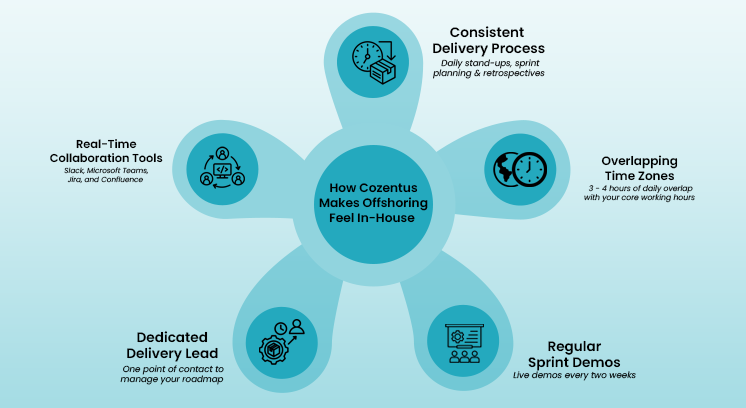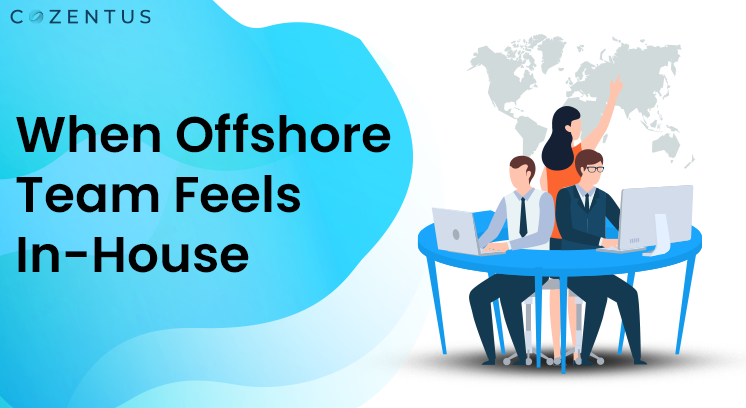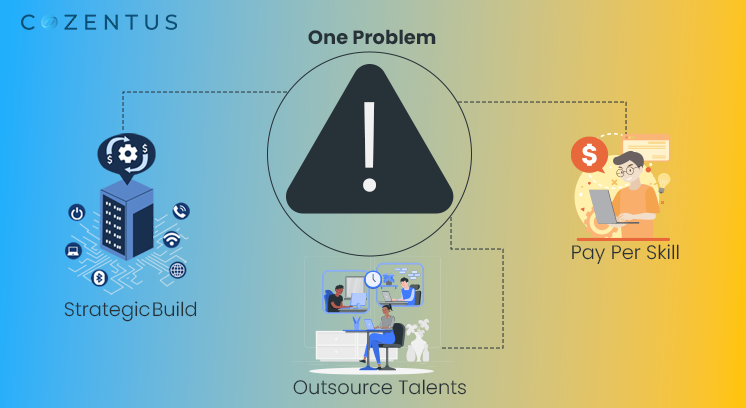Your Offshore Team Should Feel like They are in the Next Room
When you hear “offshore team,” what comes to mind?
For many business leaders, it’s late-night messages, unclear updates, and a constant worry: “Are they working on the right thing?” Offshore often feels far, not just in miles, but in communication, alignment, and control.
But what if your offshore team felt like a true extension of your own, just as responsive, just as informed, and just as invested?
That’s exactly how Cozentus works. Let’s reimagine what “offshore” can look like in 2025.

The Problem: Why Offshore Still Feels Distant for Many
We’ve all seen it:
- A team working in another time zone that’s asleep when you’re at work.
- A delivery that shows progress, but not in the direction you expected.
- A communication gap where requirements get misunderstood or delayed.
This usually leads to rework, frustration, and missed deadlines. According to McKinsey, 66% of large software projects run over budget, and 33% are late, and one major reason is poor collaboration and communication (source).
Gartner has also stated that 70% of project failures happen due to poor communication and a lack of visibility.
So, the question is: Can offshore teams work differently?
With Cozentus, the answer is “yes”.
The Cozentus Way: Offshore, But Fully Connected
Our offshore teams operate with the same transparency and ownership as your in-house teams. Here’s how we do it:

1. Dedicated Delivery Lead
You’ll have one go-to person who understands your business goals, your delivery timelines, and your expectations.
This delivery lead:
- Translates your priorities into actionable tasks for the team
- Tracks daily progress and proactively shares updates
- Flags risks early and solves problems before they grow
Think of them as your extended team manager who keeps everyone aligned, so you don’t have to chase progress or worry about miscommunication.
Why it matters: You stay focused on strategy while your delivery lead ensures smooth day-to-day execution.
2. Real-Time Collaboration Tools
We work in the tools you already use, such as Slack, Microsoft Teams, Jira, and Confluence. You get full access to our communication channels, project boards, and delivery docs.
You’ll see:
- Task updates and blockers in Jira
- Real-time discussions and decisions in Slack or Teams
- Design files, test reports, and sprint notes in shared folders
Why it matters: You get complete transparency, no hidden work, no surprises, and no black boxes. It’s like your team is sitting a few desks away.
3. Overlapping Time Zones
We plan our team’s schedules to ensure that we have at least 3 - 4 hours of daily overlap with your core working hours.
That means:
- Live stand-ups and check-ins at times that work for you
- Quick responses to questions or blockers
- No long overnight delays to get things moving
Why it matters: Decisions don’t get stuck. Priorities don’t get lost in email threads. Progress continues even after your day ends.
4. Regular Sprint Demos
Every two weeks, you’ll see exactly what’s been built. This includes live, working product demos, and not just status slides.
We walk you through:
- What was completed
- What feedback we heard last time
- What we’re building next
Why it matters: You stay involved and accurately informed. We continue to deliver what truly adds value to your business, not just what we think you want.
5. Consistent Delivery Process
We follow a consistent and agile approach that keeps everyone focused, aligned, and productive.
Here’s our core rhythm:
- Daily Stand-Ups: A quick, 15-minute check-in to share progress, flag blockers, and set priorities for the day. This keeps everyone aligned, especially across different geographical areas.
- Sprint Planning & Grooming: Once a week, we review the backlog together, break down new features, and plan what to build next. This helps to ensure we’re always working on what matters the most.
- Sprint Retrospectives: At the end of each sprint, we reassess as a team on what worked well and what could be improved. And then we adapt accordingly.
Why it matters: This structure builds momentum. You always know what’s happening, what’s coming up, and how we’re improving.
Also Read: How to Choose the Right Offshore Development Centre for your Supply Chain
A Day in the Life: Offshore That Feels Local
Let’s take an example.
Meet Gargi, Head of Product at a retail-tech company. She’s working with Cozentus on building a new customer analytics dashboard.
- 10:00 AM : She checks Teams. There’s a short message from the Cozentus team summarizing what’s been done and a question that needs her input.
- 11:30 AM : Stand-up meeting with the team on Teams. Quick, focused. Everyone is clear on what’s next.
- 1:00 PM : She joins a live sprint demo. The new dashboard filters are working great. She gives some feedback, and the delivery lead notes it for the next sprint.
- 5:00 PM : She gets a short email summary from the delivery lead that states what was completed, what’s coming up, and any actions needed from her side.
No confusion. No chasing. Just results.
What Clients Usually Worry About and How We Address It
| Common Concern | Old Offshore Model | Cozentus Model |
|---|---|---|
| No visibility | You wait for updates | You see progress daily via Slack & Jira |
| Time zone delays | You lose a full day over a small clarification | You get 3 - 4 hours of real-time work overlap |
| Unclear ownership | You’re not sure who to ask | You have a dedicated delivery lead |
| Poor alignment | Teams build what they “think” is needed | You see live demos every 2 weeks |
| Missed deadlines | Issues aren’t spotted early | You get weekly reports and course corrections |
Why It Works: What the Data Shows
- McKinsey found that using digital tools like Slack, Teams, and Jira can improve productivity by 20–30%, especially in complex or process-heavy projects.
- Most global teams succeed when there's strong communication and trust. Yet, 75% of cross-functional teams struggle, especially when offshore teams are disconnected.
- According to PMI, something as simple as daily stand-ups can increase project success by 25%. Add collaborative tools, and teams respond faster and work more smoothly.
In short: Communication + Transparency = Control + Clarity
Final Thought: Offshore Is Not About Distance. It’s About Design.
Offshore doesn’t have to mean disconnected.
With the right structure, tools, and team culture, your offshore team can feel just as in sync as your local one. You don’t need to lower expectations — you just need a partner who works differently.
At Cozentus, we don’t just build software, we build trust. Our offshore teams are built to deliver results, not for you, but with you. It’s a partnership designed for modern business leaders who want control, clarity, and consistency, irrespective of where the team sits.
Ready for Offshore That Feels In-House? Let’s Talk.
Recent Post
Subscribe to our newsletter
Stay updated on latest trends and news in the supply chain and logistics industry
Join our mailing list for monthly updates
Download Reports
AI-Powered Intelligent Document Processing -Your Launchpad to Digital Transformation
Download






